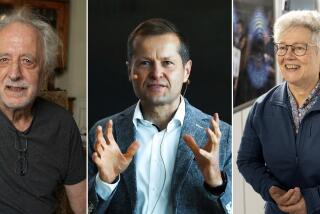‘We can hear the universe’: Scientists detect gravitational waves, predicted by Einstein
- Share via
More than a billion years ago, in a galaxy far away, two black holes surrendered to one another’s inexorable attraction and collided with such force that it disturbed the very fabric of the universe.
On Thursday, scientists announced to the world that they had detected the ripple-like gravitational waves that still course from this violent event and simultaneously confirmed a prediction made by Albert Einstein a century ago.
The detection, made with the Laser Interferometer Gravitational-Wave Observatory, known as LIGO, is the culmination of a decades-long search for signs of this elusive phenomenon — and an achievement some said was on par with the discovery of the Higgs boson, which earned its theorists a Nobel Prize in 2013.
The discovery, described in a paper in Physical Review Letters, will open a new window onto the universe, said David Reitze, executive director of LIGO, which was designed and built by researchers at Caltech and the Massachusetts Institute of Technology.
“This was truly, I think, a scientific moonshot,” Reitze said at a news briefing at the National Press Club in Washington. “I really believe that. And we did it. We landed on the moon.”
Since humans first gazed skyward, they have relied on light of all wavelengths to describe their universe. Visible light first revealed the starry heavens, while infrared allowed us to peer further back in time and see older, more distant stars. Radio waves revealed the afterglow of the universe’s violent birth, as X-rays showcased the supernova deaths of massive stars.
But now, researchers will be able to sense the universe in a whole new way: with their “ears.”
“We can hear gravitational waves. We can hear the universe,” Gabriela Gonzalez, LIGO’s spokeswoman at Louisiana State University, said at the briefing. “That’s one of the beautiful things about this: We are not only going to be seeing the universe, we are going to be listening to it.”
The telltale ripples were picked up just before 2:51 a.m. PDT on Sept. 14 by the twin LIGO detectors — one in Hanford, Wash., and the other in Livingston, La. — a mere three days after the detectors had gone live following a five-year upgrade.
“Nature was kind,” said Mustafa Amin, a cosmologist at Rice University who was not involved in the work.
The twin detectors are shaped like Ls with legs of equal length, 2.5 miles long. At the L’s corner, a laser beam is split and sent into both legs, then reflected back to the corner once it reaches mirrors in each leg. If both arrive at the same time — which they should — they’ll cancel each other out.
However, if a gravitational wave passes through, it will squeeze one leg and stretch the other, causing the distance to change and thus creating slight differences in timing that push the light waves out of phase, and the lasers will reach the photodetector. The detector is able to pick up discrepancies between the two beams that are a ten-thousandth the width of a proton.
Gravitational waves, which Einstein predicted as part of his general theory of relativity, occur as objects accelerate or decelerate through space, much the way a boat moving on a lake sends ripples across the water’s surface. But they’re so tiny that until now it’s been nearly impossible to detect them, even those caused by something as large as a planet moving around the sun.
So to pick up this signal, scientists have to look for massive, violent events in the universe. This particular signal appears to have been caused by a collision that occurred about 1.3 billion years ago between two black holes, holding 29 and 36 solar masses.
During the smash-up, the two black holes combined into one, and turned about three suns’ worth of mass into gravitational waves. Though the event lasted only 20 milliseconds, the peak power output was about 50 times the output of all the stars in the visible universe, said Caltech physicist Kip Thorne, one of LIGO’s three founders along with Caltech colleague Ronald Drever and MIT’s Rainer Weiss.
“This is amazing. Spectacular,” said Marc Kamionkowski, an astrophysicist at Johns Hopkins University who was not involved in the work. “It’s a major, major triumph for experimental physics.”
In its previous incarnation, LIGO ran from 2002 until 2010 without making any detections. That the National Science Foundation-funded project was able to make a detection just days after starting up was thanks to a much-needed five-year upgrade.
Kamionkowski guessed that hundreds of new events will be found over the next few years, allowing scientists to perform a range of different types of studies, including population surveys of these phenomena.
The LIGO result is also the first observation of a black-hole merger, and it offers a preview of the other high-energy phenomena in the universe that gravitational wave astronomy might reveal to star-gazing scientists.
“There’s probably even events we haven’t dreamed of,” said Fiona Harrison, chair of Caltech’s division of physics, mathematics and astronomy. “This is just the beginning.”
Twitter: @aminawrite
MORE IN SCIENCE:
Astronomers’ findings point to a ninth planet, and it’s not Pluto
Belief in all-knowing, punitive gods aided the growth of human societies, study says
In war-torn Afghanistan, astronomer sees hope and promise in the study of the heavens







